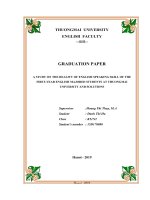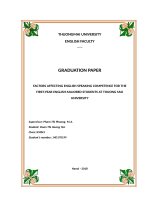Khóa luận tốt nghiệp an investigation into the difficulties in listening comprehension of first year english majored students at vnua
Bạn đang xem bản rút gọn của tài liệu. Xem và tải ngay bản đầy đủ của tài liệu tại đây (1.27 MB, 59 trang )
VIETNAM NATIONAL UNIVERSITY OF AGRICULTURE
FACULTY OF EDUCATION AND FOREIGN
LANGUAGES
BA THESIS
AN INVESTIGATION INTO THE DIFFICULTIES IN
LISTENING COMPREHENSION OF FIRST-YEAR
ENGLISH-MAJORED STUDENTS AT VNUA
NGHIÊN CỨU NHỮNG KHÓ KHĂN TRONG VIỆC
NGHE HIỂU TIẾNG ANH CỦA SINH VIÊN NĂM THỨ
NHẤT NGÀNH NGÔN NGỮ ANH - HỌC VIỆN NÔNG
NGHIỆP VIỆT NAM
Student: HOANG THE KY
Student code: 621267
Major: ENGLISH
Supervisor: NGUYỄN THỊ KIM QUẾ, M.Ed
Hanoi – 2021
CERTIFICATE OF ORIGINALITY
I, the undersigned, hereby certify my authority of the study project report
entitled
“An investigation into the difficulties in listening comprehension
of first-year English majors at VNUA” submitted in partial fulfillment of the
requirements for the degree of Bachelor in English Language. Except where the
reference is indicated, no other person’s work has been used without due
acknowledgement in the text of the thesis.
Hanoi, 2021
Hoang The Ky
Approved by
SUPERVISOR
Date:……………………
i
ACKNOWLEDGEMENT
During the process of fulfilling this graduation paper, I have received
enormous assistance, precious ideas, and timely encouragement from my
teachers, family, and friends. I would like to acknowledge and extend my great
thanks to many people, without whom this study couldn’t have been completed.
First and foremost, I would like to show my deepest appreciation to my
supervisor, M.Ed Nguyen Thị Kim Que, who has supported me throughout my
thesis with her knowledge and enthusiasm. I would also like to express my
gratitude to M.A Le Thi Hong Lam for her enthusiastic guidance. These two
lecturers’ detailed comments and useful advice have helped me shape my ideas
and achieve my aims. They have also provided me with many useful materials
as well as encouraged and created favorable conditions for me to fulfill this
research. Therefore, it is an undeniable fact that this paper would have not been
completed without their invaluable support.
Secondly, I am extremely grateful to all the lecturers of Faculty of
Education and Foreign Languages in Vietnam National University of
Agriculture for their awesome lectures that have helped me to stimulate my
interest in the English language and enriched my academic knowledge of
English during the past four years.
In addition, I warmly thank all my friends for their encouragement and
precious assistance throughout the process of writing the thesis. Their material
and spiritual support is a great driving force for me. Especially, I am deeply
grateful to the 80 first-year English-majored students for their enthusiastic and
effective cooperation in the process of completing the survey questionnaire.
Last but not least, I am greatly indebted to my parents, who have always
encouraged and supported me to fulfill this graduation thesis.
HaNoi, 2021.
ii
ABSTRACT
Many students fail to seize them because of some learning difficulties in
listening classes. Teachers should be aware of students’ learning difficulties.
This study is aimed to investigate the difficulties in listening comprehension of
first-year English-majored at VNUA. A survey questionnaire is used to collect
information about the subjective and objective causes leading to the students’
unsatisfactory results in their listening tests. Results show listening skill is a
difficult skill and there are many factors that make listening comprehension
difficult. In the last section, some suggestions for improvement are put forward.
iii
TABLE OF CONTENTS
CERTIFICATE OF ORIGINALITY ....................................................................................... i
ACKNOWLEDGEMENT...................................................................................................... ii
ABSTRACT ......................................................................................................................... iii
TABLE OF CONTENTS ...................................................................................................... iv
LIST OF ABBREVIATIONS ............................................................................................... vi
LIST OF TABLES ............................................................................................................... vii
LIST OF FIGURES ............................................................................................................. vii
Part 1: INTRODUCTION ..................................................................................................... 1
1.1. RATIONALE FOR THE STUDY ................................................................................... 1
1.2. AIMS AND OBJECTIVES OF THE STUDY ................................................................. 2
1.3. RESEARCH QUESTIONS ............................................................................................. 2
1.4. SCOPE OF THE STUDY................................................................................................ 3
1.5. SIGNIFICANCE OF THE STUDY ................................................................................. 3
1.6. DESIGN OF THE STUDY ............................................................................................. 3
Part 2: DEVELOPMENT ....................................................................................................... 5
Chapter 1: LITERATURE REVIEW...................................................................................... 5
1.1. REVIEW OF PREVIOUS STUDIES (AT HOME & ABROAD) .................................... 5
1.1.1. Review of previous studies at home .............................................................................. 5
1.1.2. Review of previous studies abroad................................................................................ 7
1.2. REVIEW OF THEORETICAL BACKGROUND ........................................................... 8
1.2.1. Definition of Listening and Listening Comprehension .................................................. 8
1.2.2. Factors affecting English listening skills ....................................................................... 9
1.2.3. Difficulties in English listening comprehension - causes and solutions ....................... 12
Chapter 2: METHODOLOGY ............................................................................................. 18
2.1. RESEARCH METHODOLOGY ................................................................................... 18
2.2. RESEARCH SETTING/CONTEXT: ............................................................................ 18
2.3. DATA COLLECTION: ................................................................................................. 18
2.3.1. Data collecting instruments ........................................................................................ 18
2.3.2. Data collecting procedures ......................................................................................... 18
2.4. DATA ANALYSIS ....................................................................................................... 19
iv
Chapter 3: FINDING AND DISCUSSION........................................................................... 20
3.1. THE CURRENT STATUS OF LEARNING LISTENING SKILLS .............................. 20
3.1.1. Students' opinions on the difficulty of listening skills ................................................. 20
3.1.2. Student's listening comprehension level ...................................................................... 21
3.1.3. The problem of learning listening skills in the high school curriculum ........................ 22
3.1.4. Students' listening motivation ..................................................................................... 23
3.1.5. Time and frequency of learning listening skills ........................................................... 24
3.1.5.1. Time to learn listening per day................................................................................. 24
3.1.5.2. Frequency of learning listening skills....................................................................... 25
3.1.6. Methods and means of learning English listening ....................................................... 26
3.1.6.1. Listening method ..................................................................................................... 26
3.1.6.2. Listening media ....................................................................................................... 27
3.1.7. Listening strategies ..................................................................................................... 27
3.1.7.1. Note-taking skills .................................................................................................... 27
3.2. DIFFICULTIES LEARNING LISTENING SKILLS .................................................... 28
3.2.2. Difficulties in vocabulary ........................................................................................... 30
3.2.3. Difficulties in grammatical structure........................................................................... 32
3.2.4. Difficulties in concentration ....................................................................................... 33
3.3. SOLUTIONS ................................................................................................................ 36
Part 3: CONCLUSION ........................................................................................................ 39
1. RECAPITULATION ....................................................................................................... 39
2. CONCLUDING REMARKS ........................................................................................... 39
2.1. Solutions for phonetics .................................................................................................. 40
2.2. Solutions for vocabulary................................................................................................ 40
2.3. Solution for concentration ............................................................................................. 41
3. LIMITATIONS OF THE STUDY.................................................................................... 41
4. SUGGESTIONS FOR FURTHER RESEARCH .............................................................. 42
REFERENCES .................................................................................................................... 43
APPENDIX ......................................................................................................................... 45
v
LIST OF ABBREVIATIONS
VNUA
EFL
L2
UTEHY
Vietnam National University of Agriculture
English as a Foreign Language
Second Language
Hung Yen University of Technology and
Education
FE
Faculty of Education
vi
LIST OF TABLES
Table 1: Listening learning method ...................................................................................... 26
Table 2: Listening media ...................................................................................................... 27
Table 3: Difficulties in phonetic ........................................................................................... 28
LIST OF FIGURES
Figure 3.1 ......................................................................................................... 20
Figure 3.2 ......................................................................................................... 21
Figure 3.3 ......................................................................................................... 22
Figure 3.4 ......................................................................................................... 23
Figure 3.5 ......................................................................................................... 24
Figure 3.6 ......................................................................................................... 25
Figure 3.7 ......................................................................................................... 26
Figure 3.8 ......................................................................................................... 27
Figure 3.9 ......................................................................................................... 31
Figure 3.10 ....................................................................................................... 33
Figure 3.11 ....................................................................................................... 34
vii
Part 1: INTRODUCTION
1.1. RATIONALE FOR THE STUDY
No one can deny the importance of listening skills in foreign language
learning because the key to acquire a language is to receive language input
(Mohammed, 2016). Listening plays an important role in communication as it is
said that, of the total time spent on communicating, listening takes up 40-50%;
speaking, 25- 30%; reading, 11-16%; and writing, about 9% (Gilakjani and
Ahmadi, 2011). Listening is an active process that involves deciphering and
constructing meaning from verbal and non-verbal messages (Nunan, 1998).
Effective communication therefore necessitates that learners develop the
listening skills deemed essential for understanding input for any learning to
begin (Nunan, 1998; Rost, 1994). EFL learners have serious problems in English
listening comprehension due to the fact that universities pay more attention to
English grammar, reading and vocabulary (Dwi Rara Saraswaty, 2018). This is
considered the common situation of many EFL students.
Furthermore, Hamdona (2007) indicates that English language plays an
important role in everyday situations all over the world. It's a universal language
which deals with all aspects of life. Genc (2007:p.6) states that when we learn a
language, there are four skills that we need for complete communication. When
we learn our native language, we usually learn to listen first, then to speak, then
to read and finally to write. Abu Hatab (2010:p.2) indicates that listening skill
plays a significant role in daily communication and educational process. In spite
of this importance, listening ability has received only slight care in the language
teaching. Moreover, Assaf (2015:p5) states that listening can be major skill
helping in acquiring English language. Gilakjani (2016) also says that listening
1
skill is very important in foreign language learning because the key to learn a
language is to receive language input.
Phung Thi Tho (2017) pointed out learning listening skills is the most
difficult in learning a foreign language. Especially for freshman of English
linguistic major, learning L2 (English) listening comprehension still faces many
difficulties and limitations. It is likely that students have not optimized their
listening skills, most of them have not yet reached the set target. Therefore, to
learn English listening comprehension skill effectively, the ability to practice
should be developed and trained more actively, especially in the freshman stage.
Realizing this is a rather essential problem and want to find some useful
solutions to help students, I decided to choose the topic “An investigation into
the difficulties in listening comprehension of first-year English majors at
VNUA” to research the cause and the solution.
1.2. AIMS AND OBJECTIVES OF THE STUDY
Aim:
The purpose of the study is to find out the difficulties in listening
comprehension of first-year English majors at VNUA and suggest some
solutions to help them overcome the difficulties.
Objectives:
- To figure out the difficulties that first-year English-majored students face
in English listening comprehension.
- To find out the causes of the difficulties and to suggest some solutions.
1.3. RESEARCH QUESTIONS
- What difficulties do first-year English majors have in English listening
comprehension?
- What solutions can help the students to overcome the difficulties?
2
1.4. SCOPE OF THE STUDY
Research object: Listening skills of first-year English major students at
VNUA
Research subject: English learning process of English major students at
VNUA
Scope of study: 80 K65 English-majored students.
1.5. SIGNIFICANCE OF THE STUDY
1- This study helps teachers to know the difficulties that the students are
struggling with to improve their listening skills.
2- This study helps English-majored students at VNUA to realize the causes
of their difficulties in listening comprehension and the solutions to overcome
their difficulties.
3- This study may be beneficial to other learners of English as well.
1.6. DESIGN OF THE STUDY
Apart from the acknowledgement, the abstract, references and appendices,
this study consists of three main parts:
PART 1 - INTRODUCTION presents the rationale of the study, aims and
objectives of the study, research questions, the scope and the significance of the study.
PART 2 - DEVELOPMENT is composed of 3 chapters:
Chapter 1 - LITERATURE REVIEW - provides theoretical background for
the study including the definition of listening and listening comprehension,
Types of listening, Factors affecting English listening skills, and Difficulties in
English listening comprehension - causes and solutions
3
Chapter 2 – METHODOLOGY describes the methodology used in the
research including the research methods, research setting/ context, data
collection, and data analysis.
Chapter 3 - FINDINGS AND DISCUSSIONS - reports and discusses the
findings of the study.
PART 3 - CONCLUSION summarizes the main issues that have been
addressed in the study, points out the limitations, draws pedagogical
implications concerning the research topic and recommends several solutions to
English-majored students at VNUA to overcome the difficulties in listening
comprehension.
4
Part 2: DEVELOPMENT
Chapter 1: LITERATURE REVIEW
1.1. REVIEW OF PREVIOUS STUDIES (AT HOME & ABROAD)
1.1.1. Review of previous studies at home
Vietnam is one of the countries where English is considered one of the
foreign languages - the main communication tool, so the teaching of English is
much focused. This is reflected in the Law on Education of Vietnam, the
Ministry of Education and Training has enhanced the importance of learning
English by bringing English into teaching right from the elementary level.
Teaching and learning foreign languages in Vietnam has made great efforts but
is not really effective and has many limitations, so what is the cause? Maybe it is
due to the training program, the teaching method, or the assessment method is
not correct and does not reflect the essence, the assessment results do not meet
the requirements and purpose of the assessment. There have been a lot of
researches aimed at renewing the curriculum of the Ministry of Education and
Training such as: changing textbooks, fostering pedagogical and professional
qualifications for teachers, changing testing methods, assessment of learners'
learning results... However, it is necessary to have support in our teaching and
learning about the student's learning outcomes assessment model to re-influence
the teaching process and learning foreign languages in general and English in
particular.
Vietnam has had many studies on methods to improve the quality of foreign
language teaching and learning, but studies in Vietnam are incomplete, and there
are no in-depth studies on foreign language learning capacity based on
assessment frameworks, specific capacity. Although English is only a tool to
5
communicate, how to effectively teach and study: innovating teaching methods
or adjusting current assessment methods. These are two issues that are quite
closely related. Objectives and roles of foreign language teaching and learning
have been reaffirmed, the purpose of foreign language teaching is defined as
teaching communication skills or in other words teaching communication skills
for students. This view is absolutely correct and has been proven by the series of
requirements of employers in fluent in foreign languages. Therefore, learning a
foreign language is not just simply learning vocabulary and grammar, but also
learning communication.
Dang Thi Thu Thuy (2019) pointed out most students thought that learning
the listening skills was the hardest, and some students thought the listening skills
were relatively new, even though the students experienced the least English
learning 3 years in primary school and in grade 6,7. Meanwhile, the period of
training at junior high school according to the distribution of each semester was
more than 50 periods (3 periods/ week), in 18 weeks in a semester, the amount
of time spent on listening comprehension was too little. The aim of the study
was to discover the factors affecting the listening comprehension of 8 th-grade
students at a junior high school in Thai Nguyen. The participants of the study
included 90 grade 8 students from 3 classes and 5 teachers of English at Nha
Trang junior high in Thai Nguyen.
Phung Thi Tho’ study (2017) was divided into four chapters with their own
purpose. The study's theories are briefly discussed in the first chapter. The
second part gave an overview of the scenario at FE, UTEHY when it came to
studying English listening skills. Through questionnaires and interviews, the
author presented the research methods and conclusions of the approach to
listening at FE in the third chapter. This chapter also assists the author in
determining the answers to the three research questions presented in the
6
introduction. The final chapter contains some suggestions and recommendations
for improving English listening skills at UTEHY.
1.1.2. Review of previous studies abroad
There are a lot of studies abroad about listening skills, here are some related
foreign studies:
Sarah C. Wayland (2010) developed what are now known as elements that
affect foreign language listening comprehension, focusing on listener
characteristics, passages, and testing conditions.
Ahmed Al-Alwan, Sahail Asassfeh & Yousef Al-Shboul (2013) pointed out
that The existing literature supports the responsibility metacognitive abilities
embody in learning because they allow learners to be consciously aware of the
learning processes taking place; a learning task entails some cognitive
requirements and necessitates searching for the most effective strategies learners
have available to choose from. This study was conducted on a suitable sample of
386 10th graders from public schools in Amman, Jordan's capital city (207
females and 179 males). The participants, on average, were 16-year-old native
Arabic speakers who had been studying English for ten years. According to their
teachers, their competency level is low intermediate.
Mohammed Mousa El- Nahhal (2016) pointed out that language is a type of
social interaction. It is a type of communication that takes place between
individuals. In the age of globalization, the world of technology, information,
and the internet, English is becoming increasingly important for everyone who
wants to keep up with the rapid changes in the modern world. Through the eyes
of instructors, this study sought to uncover the challenges of developing
listening skills for young learners. The study included 68 instructors (male and
female) from Rafah Governmental schools that teach grades one through six.
7
The research sample consisted of 40 instructors (male and female) who were
picked at random by the researcher.
In a seminal study, Dwi Rara Saraswaty (2018) reviewed when listening to
oral texts, the learners were taught listening comprehension methods and
subsequently their difficulties with listening comprehension were detected. This
study aimed to raise teachers' awareness of these challenging listening regions
so that appropriate and effective interventions might be taken. Understanding
students' learning challenges may allow EFL teachers to assist students in
developing effective learning techniques and, as a result, improving their
English listening skills. This study focuses on how instructors may improve their
positive attitude and train them to be responsive by providing them with
appropriate techniques for improving their listening abilities.
1.2. REVIEW OF THEORETICAL BACKGROUND
1.2.1. Definition of Listening and Listening Comprehension
a. Definition of Listening
According to Field (1998), ‘Hearing is an invisible mental process, and
therefore difficult to describe. The listener must be able to distinguish sounds,
understand vocabulary and grammatical structures, grasp the speaker's stress and
intent, and be able to recall and understand it in the socio-cultural context of the
utterance. '
Anderson & Lynch (1988) give the following definition of listening
comprehension: 'Listening means understanding what the speaker has said. The
listener plays a particularly important role in the listening process by using his
diverse knowledge to analyze what he hears so that he can understand the
speaker's utterances.'
8
Wolvin & Coakley (1985) defines hearing in a simpler way: 'Hearing is the
process by which the auditory organ receives, processes and determines the
message of speech.'
Listening is one of the most important aspects of successful communication
because it helps us understand the world around us. The ability to recognize and
comprehend what others are saying is known as listening. Understanding a
speaker's accentor pronunciation, grammar and vocabulary, and comprehension
of meaning are all part of this process
b. Definition of Listening Comprehension
Various authors have defined the word "listening comprehension." Listening
comprehension is a complicated, participatory process in which listeners
participate in a dynamic creation of meaning. Sound discrimination, past
knowledge of language, grammatical structures, stress and intonation, as well as
other linguistic, paralinguistic, or even nonlinguistic indicators in contextual
speech help listeners grasp the oral input. Listening comprehension means that a
person comprehends what he or she has heard. He will understand the text if he
learns it from hearing it.
1.2.2. Factors affecting English listening skills
There are a lot of difficulties that learners may encounter in the
comprehension processes and the purpose is to be aware of these problems and
try to solve them. Some of these problems are as follows:
1) Quality of Recorded Materials
Teachers in certain classes use low-quality recorded materials in their
lessons. The quality of the sound system can affect how well students
understand what they are hearing.
9
2) Cultural Differences
Learners should be aware of the cultural aspects of language that have a
substantial impact on their comprehension. If the listening job includes wholly
diverse cultural components, the students may have serious understanding
issues. Teachers are responsible for providing background information about the
listening activities ahead of time.
3) Accent
Too much accented speech can result in a significant loss of comprehension.
One of the most critical elements affecting listener understanding, according to
66 percent of learners, is a speaker's accent. Unfamiliar accents, both native and
non-native, can create significant listening comprehension issues, whereas
familiarity with an accent aids learners' comprehension. Listeners who have only
studied American English will have serious listening difficulties when they hear
an unusual accent such as Indian English for the first time. This will
undoubtedly disrupt the entire listening comprehension process, and an unusual
accent will make comprehension difficult for the listeners.
4) Unfamiliar Vocabulary
It would be quite straightforward for pupils to identify recognized terms in
hearing readings. When students understand the meaning of words, it may pique
their interest and motivation, as well as improve their listening comprehension.
Many words have many meanings, and students will become confused if they
are not utilized correctly in their respective settings.
5) Length and Speed of Listening
When students listen to extended portions and retain all information, their
level can play a significant impact. Lower-level pupils find it challenging to
listen for more than three minutes and finish the listening exercises. Learners
10
will have an easier time understanding short listening passages and will be less
fatigued. The section might be difficult to listen to because of the speed.
Students may struggle to grasp L2 terms if the presenters talk too quickly.
Listeners are unable to regulate the speed of speakers in this situation, which
might cause serious issues with understanding. There are a few barriers in the
way of good listening comprehension. For starters, listeners have little influence
over speech pace. The most significant issue with listening comprehension is
because listeners have little influence over how rapidly speakers speak. Second,
listeners cannot have words repeated to them, which might cause serious
problems. A recorded segment cannot be replayed by students. Teachers choose
what and when to repeat listening readings, and it's impossible for them to
determine whether or not their students comprehended what they heard. Third,
listeners don't have a large vocabulary. Speakers may choose terms that are
unfamiliar to them. They may come across a new term that causes them to pause
and ponder about the meaning of the word for a few moments, causing them to
miss the rest of the speech. Fourth, listeners may be unaware of the context.
Listeners may find it simpler to communicate if they have mutual knowledge
and are familiar with the texts. Listeners can occasionally understand the surface
meaning of a piece, but unless they are familiar with it, they may have
significant difficulty understanding the entire content. Fifth, it's difficult for
listeners to focus on the listening text. A little lapse in concentration might
sometimes hinder understanding. Listeners will have an easier time
concentrating if the listening passage is fascinating to them.
6) Listening materials
Other issues with listening comprehension are linked to the type of listening
materials used. Teachers do not teach their students listening skills since it is not
a priority. One of the most severe issues with listening comprehension is the
11
pronunciation of words that differs from their printed form. Because spoken
language differs from written language in terms of pronunciation, pupils may
have difficulty recognizing words that make up spoken speech. Students should
strive to determine which linguistic element corresponds to the word in addition
to identifying the terms despite their unfamiliar sound.
Oral passages exist in real time and should be digested quickly, leaving just
a mental picture after the passage is over. Listening necessitates quick
processing in order to return to the spoken material, making it more difficult
than reading. Listening comprehension can be influenced by a student's cultural
background knowledge. Listening processes might be aided by a broad grasp of
the country's culture and history. Listeners can form inferences and recognize
speakers' suggested meaning using pragmatic knowledge, which teachers should
take into account while teaching listening comprehension. The most common
causes of difficulty for learners' hearing comprehension include new words,
complex grammatical structures, and the length of spoken passages. He went on
to say that pupils' listening comprehension problems stem from a lack of clarity,
a lack of engagement, and a need for comprehensive responses to listening
comprehension questions. There are four possible causes for difficulties with
listening comprehension. The message, the speaker, the listener, and the
physical setting are all involved.
The major components that impact listening comprehension are the listener,
speaker, medium, and environment. Students' hearing comprehension is
influenced by four variables: listener factors, speaker factors, stimulus factors,
and context factors.
1.2.3. Difficulties in English listening comprehension - causes and solutions
Difficulties are described as internal and external features that may interfere
with understanding of a hearing text and are linked to cognitive operations that
12
occur at various levels of listening comprehension. It is very important to teach
listening strategies to students and before doing this, teachers should increase
learners’ knowledge of vocabulary, grammar, and phonology. The creation of a
strategy is important for listening training, since it allows students to direct and
analyze their own comprehension and responses. Depending on the learners'
level, these techniques may differ.
What makes listening difficult in a second language?
The researcher may deduce from the above presentation of past studies that
many researchers focused on the Listening Comprehension Problems and
challenges
faced
by
English
foreign
language
learners
in
listening
comprehension. This is seen as a strong sign that teachers are in desperate need
of adopting and adapting new approaches and procedures, such as problems in
teaching young learners to listen through the eyes of teachers. The present study
builds on earlier research in terms of writing definitions and listening problems.
Furthermore, while drafting the introduction, the current study draws on past
research.
Not all of the issues listed above can be solved. Certain aspects of the
message, such as the speaker, are unavoidable. However, this does not rule out
the possibility of the instructor intervening. At the very least, teachers may give
students with appropriate listening materials, background and language
knowledge, enabling abilities, pleasant classroom circumstances, and helpful
activities to assist them in identifying successful listening techniques. Here are a
few suggestions:
1. Adapting and Improving Listening Materials
It is obvious that students differ in their learning styles and ability, therefore,
teachers should adopt and adapt listening materials that match their students’
13
interest and background since the listening materials only become stimulating
and motivating them when they are slightly challenging to what they have
already known and suit their interest.
2. Activating your Students’ Vocabulary
One of the major factors preventing pupils from understanding what they are
hearing is a lack of vocabulary. The majority of students say they don't have
enough vocabulary for listening comprehension, while a tiny percentage say
their vocabulary is too limited to understand. Teachers must thus provide pupils
with specific essential terms necessary for listening comprehension, since a lack
of vocabulary is a significant barrier to their comprehension. However, it is
preferable to engage students' vocabulary by asking them to identify the
meaning of terms used in the listening context before teaching the meaning to
them, since when students are able to link what they are hearing to what they are
hearing, they are more likely to remember it.
3. Using Different Kinds of Input
The teacher should also provide students with different kinds of input, such
as lectures, radio news, films, TV plays, announcements, everyday conversation,
interviews, storytelling, English songs, and so on.
4. Using Visual Aids
To help students guess and envision actively, teachers use visual aids or
create images and diagrams linked to the listening subjects. Visual aids capture
learners' attention, enhance their passion for the topic, and assist them relate to
the substance of the spoken text, allowing them to overcome challenges such as
unfamiliar vocabulary and minimum pairs of words.
14
5. Accents
Make pupils aware of the many accents used by native speakers. Strong
regional accents are not ideal for listening instruction, however native speakers
do exhibit specific accents in spontaneous speech. Furthermore, the American
accent differs significantly from that of the British and Australian. As a result,
pupils must be given the opportunity to deal with a variety of dialects,
particularly during extended listening.
6. Pronunciation
According to the conclusions of the study, poor pronunciation prevents at
least some students from understanding what they are hearing, thus teachers
should assist students expose themselves to and become familiar with native
speakers' precise pronunciation. Students' ability to pronounce words correctly is
greatly increased as a result of this, making listening to native speakers more
effective and efficient for them. Many teachers believe that pupils' correct
pronunciation aids their listening comprehension. They also feel that one of the
most important outcomes of listening acquisition is to teach students how to
pronounce words correctly.
7. Connected Speech
Connected speech is characterized by weak forms, contractions, elision, and
assimilation, all of which are regarded major barriers to spoken English
acquisition for beginning EFL learners. As a result, it is the responsibility of
teachers to tell their students about these distinguishing aspects of spoken
language at any moment that is convenient for them, so that they are not stressed
or shocked while listening to real listening materials.
8. Activating Building Students’ Prior Topical and Linguistic Knowledge
To engage the schemata, encourage students to consider and discuss what
they already know about the content of the listening text. Teachers can also help
students focus on what they should listen for by giving them background
15
knowledge they need to grasp the topic. As a consequence, students learn to
predict what they will hear and make connections with what they already know,
increasing the relevance of the material.
9. Arousing Interest and Motivating Students to Attend to the Spoken Message
If students can link the listening experience to their own life, they will be
more willing to actively listen to what the speaker says. Furthermore, teachers
may foster a listening-friendly environment and develop good listening
practices, which are essential life skills.
10. Encouraging Prediction
This method may be used in both the pre-listening and listening stages.
Students are given the task of predicting what the text will be about or what the
speaker will say next. The instructor may say anything about the topic of the
listening text or about the speakers to help students to anticipate and predict
what they will hear. Students can also be asked to anticipate which grammatical
structures will be used in the listening text or to create a list of terms and phrases
that are related to the topic and may occur in the listening text. They can
acquaint students with essential concepts and terminology in this way before
they listen to spoken material. Students will be more self-assured and therefore
able to listen well if they have specific language in mind.
11. Using Slow Rate of Speech
It has long been thought that training L2 students to speak at a slower tempo
will help them understand what they are hearing. Lecturers should be instructed
to slow down their speech tempo to a level that is comfortable for their pupils.
12. Providing and trying to Gain as
As much feedback as possible. To make listening worthwhile, the instructor
should bridge the gap between inputs and students' responses, as well as
between the teacher's comments and students' reactions, during the course. This
16
not only encourages error repair but also provides encouragement. It can help
kids gain confidence in their abilities to deal with listening difficulties. The
instructor can use student input to determine where the class is headed and how
it should be instructed.
13. Improving the Learning Environment of Listening Skill
A significant factor impacting the quality of both learning and teaching
listening skill is the learning environment, which includes a listening laboratory
in addition to cassette recordings, tape recorders, and listening texts. The results
of this survey, however, reveal that pupils are dissatisfied with the current
learning environment. Students say that there is still a shortage of well-equipped
listening laboratories, which makes it difficult for them to concentrate when
listening. As a result, it is critical to update the current laboratory so that all
students have an equal and enough opportunity to learn listening skills in such a
compelling setting.
17









